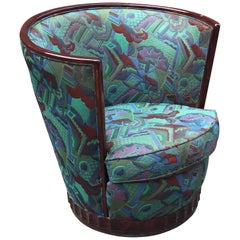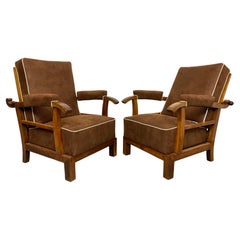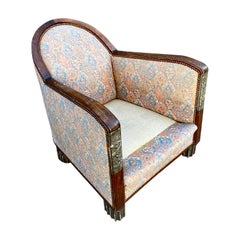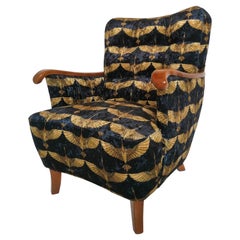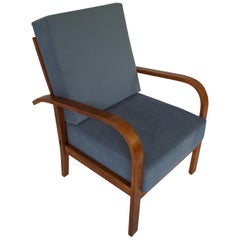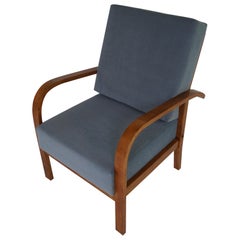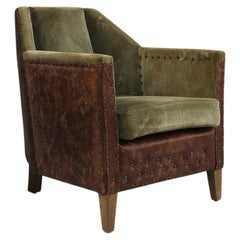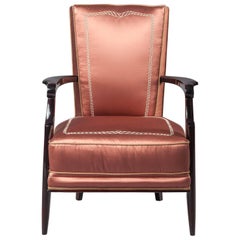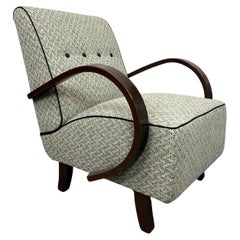Art Deco Armchairs
Vintage 1950s French Art Deco Armchairs
Beech
Vintage 1930s Slovak Art Deco Armchairs
Walnut
Vintage 1930s French Art Deco Armchairs
Wood
Vintage 1920s Czech Art Deco Armchairs
Walnut
Vintage 1940s Czech Neoclassical Armchairs
Walnut
Vintage 1940s Czech Neoclassical Armchairs
Walnut
Vintage 1930s Belgian Art Deco Armchairs
Velvet, Faux Leather
Vintage 1930s French Art Deco Armchairs
Palisander
Vintage 1930s Slovak Art Deco Armchairs
Fabric, Beech, Bentwood
Vintage 1930s Czech Art Deco Armchairs
Walnut
Vintage 1930s European Armchairs
Leather, Wood
Vintage 1920s Armchairs
Wood
20th Century Armchairs
Fabric, Wood
Vintage 1930s French Art Deco Armchairs
Hardwood
Early 20th Century European Art Deco Armchairs
Leather, Faux Leather, Birch
Vintage 1950s French Art Deco Armchairs
Upholstery, Wood
Vintage 1930s French Art Deco Armchairs
Beech
Early 20th Century English Art Deco Armchairs
Velvet
Vintage 1930s French Art Deco Armchairs
Cherry
Vintage 1930s European Art Deco Armchairs
Walnut
Vintage 1930s French Art Deco Armchairs
Upholstery, Oak
Vintage 1940s French Art Deco Armchairs
Oak
Vintage 1930s Czech Art Deco Armchairs
Fabric, Beech, Bentwood
Vintage 1940s Czech Art Deco Armchairs
Beech, Bentwood
Vintage 1930s Art Deco Armchairs
Upholstery, Walnut
Vintage 1940s Polish Art Deco Armchairs
Walnut
Vintage 1920s French Armchairs
Leather, Cherry
Vintage 1930s French Art Deco Armchairs
Beech, Coating
Vintage 1930s French Art Deco Armchairs
Velvet, Beech
Vintage 1930s French Art Deco Armchairs
Walnut
Early 20th Century Swedish Art Deco Armchairs
Vintage 1930s French Art Deco Armchairs
Upholstery, Oak
Vintage 1920s French Art Deco Armchairs
Beech
Vintage 1920s Czech Art Deco Armchairs
Walnut
Vintage 1920s Austrian Art Deco Armchairs
Oak
Vintage 1940s European Art Deco Armchairs
Chrome
Vintage 1930s Czech Art Deco Armchairs
Walnut
Vintage 1930s Czech Art Deco Armchairs
Walnut
Vintage 1930s French Art Deco Armchairs
Velvet, Wood
Vintage 1910s Art Deco Armchairs
Fabric, Wood
Vintage 1920s Danish Art Deco Armchairs
Wood
Vintage 1940s French Art Deco Armchairs
Beech
20th Century Classical Roman Armchairs
Leather, Sheepskin
Vintage 1920s French Art Deco Armchairs
Wood
Vintage 1930s French Art Deco Armchairs
Oak
Vintage 1930s Belgian Art Deco Armchairs
Leather, Cherry
Vintage 1930s French Art Deco Armchairs
Leather, Beech
Vintage 1930s French Art Deco Armchairs
Leather, Beech
Vintage 1930s French Art Deco Armchairs
Leather, Beech
Vintage 1920s Czech Art Deco Armchairs
Fabric, Wood, Walnut, Lacquer
20th Century Armchairs
Fabric, Wood
Vintage 1930s French Art Deco Armchairs
Leather, Rosewood
Vintage 1940s Czech Art Deco Armchairs
Walnut
2010s Turkish Art Deco Armchairs
Leather, Fabric
Vintage 1970s Italian Art Deco Armchairs
Fabric, Cotton, Silk, Wood, Ash
Vintage 1920s French Art Deco Armchairs
Mahogany, Tulipwood
Vintage 1970s Italian Art Deco Armchairs
Silk, Cotton, Fabric, Wood
Vintage 1940s French Art Deco Armchairs
Upholstery, Beech
- 1
- ...
Art Deco Armchairs For Sale on 1stDibs
How Much are Art Deco Armchairs?
Finding the Right Seating for You
With entire areas of our homes reserved for “sitting rooms,” the value of quality antique and vintage seating cannot be overstated.
Fortunately, the design of side chairs, armchairs and other lounge furniture — since what were, quite literally, the early perches of our ancestors — has evolved considerably.
Among the earliest standard seating furniture were stools. Egyptian stools, for example, designed for one person with no seat back, were x-shaped and typically folded to be tucked away. These rudimentary chairs informed the design of Greek and Roman stools, all of which were a long way from Sori Yanagi's Butterfly stool or Alvar Aalto's Stool 60. In the 18th century and earlier, seats with backs and armrests were largely reserved for high nobility.
The seating of today is more inclusive but the style and placement of chairs can still make a statement. Antique desk chairs and armchairs designed in the style of Louis XV, which eventually included painted furniture and were often made of rare woods, feature prominently curved legs as well as Chinese themes and varied ornaments. Much like the thrones of fairy tales and the regency, elegant lounges crafted in the Louis XV style convey wealth and prestige. In the kitchen, the dining chair placed at the head of the table is typically reserved for the head of the household or a revered guest.
Of course, with luxurious vintage or antique furnishings, every chair can seem like the best seat in the house. Whether your preference is stretching out on a plush sofa, such as the Serpentine, designed by Vladimir Kagan, or cozying up in a vintage wingback chair, there is likely to be a comfy classic or contemporary gem for you on 1stDibs.
With respect to the latest obsessions in design, cane seating has been cropping up everywhere, from sleek armchairs to lounge chairs, while bouclé fabric, a staple of modern furniture design, can be seen in mid-century modern, Scandinavian modern and Hollywood Regency furniture styles.
Admirers of the sophisticated craftsmanship and dark woods frequently associated with mid-century modern seating can find timeless furnishings in our expansive collection of lounge chairs, dining chairs and other items — whether they’re vintage editions or alluring official reproductions of iconic designs from the likes of Hans Wegner or from Charles and Ray Eames. Shop our inventory of Egg chairs, designed in 1958 by Arne Jacobsen, the Florence Knoll lounge chair and more.
No matter your style, the collection of unique chairs, sofas and other seating on 1stDibs is surely worthy of a standing ovation.
- What is an art deco watch?1 Answer1stDibs ExpertApril 5, 2022An art deco watch is defined by its geometric case, which is either circular or rectangular. The watch style was highly popular between 1920 and 1950, and is still sought after today. You’ll find a collection of art deco watches from some of the world’s top sellers on 1stDibs
- What is art deco jewelry?1 Answer1stDibs ExpertFebruary 22, 2021Art Deco jewelry was popular during the design movement of the 1920s and 30s. Art Deco jewelry is typically characterized by geometric patterns and gemstones of contrasting colors.
- What was the Art Deco movement?1 Answer1stDibs ExpertMay 30, 2024The Art Deco movement was a decorative style popular during the 1920s and ’30s. Few design styles are as universally recognized and appreciated as Art Deco. The term alone conjures visions of the Roaring Twenties, Machine Age metropolises, vast ocean liners, sleek typography and Prohibition-era hedonism. The iconic movement made an indelible mark on all fields of design, celebrating society's growing industrialization with refined elegance and stunning craftsmanship. Widely known designers associated with the Art Deco style include Émile-Jacques Ruhlmann, Eileen Gray, Maurice Dufrêne, Paul Follot and Jules Leleu. The term Art Deco derives from the name of a large decorative arts exhibition held in Paris in 1925. On 1stDibs, shop a wide range of Art Deco furniture and decorative objects.
- What is the history of Art Deco?1 Answer1stDibs ExpertMarch 25, 2024The history of Art Deco begins in the early 20th century.
Art Deco emerged as a global design style around the start of World War I, during the last years of Art Nouveau's popularity. The style conjures visions of the Roaring Twenties, Machine Age metropolises, vast ocean liners, sleek typography and Prohibition-era hedonism. Its hallmarks include the use of geometric designs influenced by Cubism. Major discoveries of Egyptian tombs during the era also influenced the movement.
The term Art Deco derives from the name of a large decorative arts exhibition, the Exposition Internationale des Arts Décoratifs et Industriels Modernes, held in Paris in 1925. After World War II, tastes shifted toward more functional, less ornate modernism, but today, the Art Deco style is still favored for its luxurious sophistication. On 1stDibs, shop a large selection of vintage Art Deco furniture. - How do I identify Art Deco?1 Answer1stDibs ExpertApril 5, 2022To identify Art Deco, look for the characteristics of the period. Furniture produced at the time is generally lacquered metal with a mirror-like glossy finish. Wooden items should be an exotic wood. Most items feature symmetrical designs, and geometric forms were popular motifs during the period. In addition, Art Deco often shows the influence of Hellenistic, Egyptian and Asian designs. Shop a variety of Art Deco furniture and decorative objects on 1stDibs.
- When did Art Deco originate?1 Answer1stDibs ExpertFebruary 1, 2024The Art Deco period originated in France. Its name comes from the title of a large decorative arts exhibition held in Paris in 1925, credited with introducing the style to the world. It was informed by ancient Egypt, Cubism, Futurism, Louis XVI, De Stijl, modernism and the Vienna Secession and went on to influence the Streamline Moderne and mid-century modern movements. Shop a wide range of Art Deco furniture, decorative objects and jewelry on 1stDibs.
- What defines Art Deco?1 Answer1stDibs ExpertApril 5, 2024A few things define Art Deco. Date is one factor, as the style emerged in the 1920s and remained popular during the 1930s. Art Deco design usually includes bold geometric lines and forms or intricate repeating floral motifs. Designers working in this style tended to use expensive materials, such as shagreen or marble, as well as exotic woods like mahogany, ebony and zebra wood. Furniture often featured metal accents, mirrored finishes and embellishments made from exotic animal hides and inlays of mother-of-pearl or ivory. Shop a wide range of Art Deco furniture on 1stDibs.
- What was Art Deco influenced by?1 Answer1stDibs ExpertMay 3, 2024Art Deco was influenced by a number of things. The discovery of ancient tombs around the turn of the century led to a renewed interest in Egyptian furniture and architecture that inspired Art Deco designers. Art Deco was also informed by Cubism, Futurism, Louis XVI style, De Stijl, modernism and the Vienna Secession. Shop a large collection of Art Deco furniture, decorative objects and jewelry on 1stDibs.
- What is art deco ring?1 Answer1stDibs ExpertAugust 17, 2021Art Deco rings were made during the early 20th century. Named for a design movement that originated at a large decorative arts exhibition held in Paris in 1925, Art Deco rings are generally quite geometric, symmetrical and incorporate a variety of gemstones — especially sapphires and emeralds. Find a wide variety of Art Deco rings for sale on 1stDibs.
- What is an Art Deco lamp?1 Answer1stDibs ExpertApril 5, 2022An Art Deco lamp is any lamp that’s made in the styles of the Art Deco movement, which was dominant in the 1920s and 1930s. On 1stDibs, you’ll find a collection of Art Deco lamps from some of the world’s top sellers.
- 1stDibs ExpertAugust 15, 2019
The main difference between Art Nouveau and Art Deco is that the former is detailed and ornate, and the latter is sharp and geometrical. When the movement started at the end of the 19th century, Art Nouveau was heavily influenced by nature and the curved lines of flowers. Art Deco, which became popular in the beginning of the 20th century, was inspired by the geometric abstraction of cubism.
- 1stDibs ExpertApril 5, 2022There are a few tell-tale signs you can look for to determine if a ring is from the Art Deco period. The first big sign is if it has a geometric element to it, as this was a big element of all Art Deco designs. Colored stones were also very popular in the period and it’s not uncommon to see sapphires or rubies taking center stage, rather than a diamond. During the Art Deco period, yellow gold was not very common, instead, jewelers crafted pieces of white gold or platinum. Shop a collection of authentic Art Deco jewelry from some of the world’s top boutiques on 1stDibs.
- 1stDibs ExpertMarch 31, 2023The simplest way to make an Art Deco bedroom is to purchase authentic furniture and decorative accents from the 1920s and ‘30s. Top designers from the period include Émile-Jacques Ruhlmann, Eileen Gray, Maurice Dufrêne and Jules Leleu. Pair authentic Art Deco pieces with a bedding set in a colorful, intricate floral print, or dress up the walls with wallpaper in a geometric motif with hints of gold. The iconic Art Deco movement made an indelible mark on all fields of design throughout the 1920s and ’30s, celebrating society’s growing industrialization with refined elegance and stunning craftsmanship. Find a selection of Art Deco furniture and decor from some of the world's top sellers on 1stDibs.
- What era was Art Deco rings?1 Answer1stDibs ExpertJune 30, 2023Art Deco rings are from the era of the 1920s and 1930s. While Art Deco began to emerge a bit earlier than that, the style truly gained momentum after the end of World War I. Rings from the time period often feature geometric motifs, bold colors and designs that were influenced by Cubism, Futurism and other movements in visual art. Diamonds were exceptionally popular, while accent gems such as sapphires, emeralds and rubies brought vivid color to engagement rings and added sophistication and glamour. On 1stDibs, shop a variety of Art Deco rings.
- What is Art Deco’s time period?1 Answer1stDibs ExpertSeptember 25, 2019
The Art Deco era is 1925 to 1940.
- What does Art Deco ring mean?1 Answer1stDibs ExpertFebruary 17, 2023The term Art Deco ring means a ring produced in the Art Deco style. Most Art Deco jewelry dates back to the 1920s and 30s and features defined lines and geometric motifs. While a lot of Art Deco rings were black and white — the black coming from the use of onyx or black enamel and the white from rock crystal and diamonds — there is plenty of color in jewelry of the era. A perfect accent to diamonds in platinum settings were blue sapphires, emeralds and rubies, and these stones were also used in combination with each other. On 1stDibs, find a variety of Art Deco rings.
- 1stDibs ExpertMay 30, 2024There are many famous Art Deco artists. In addition, the movement produced many well-known designers and architects. Some of the most notable creatives who contributed to the Art Deco movement include Émile-Jacques Ruhlmann, René Lalique, Eileen Gray, Jean Dunand, Donald Deskey and Jean Perzel. Explore a wide range of Art Deco furniture and decorative objects on 1stDibs.
- 1stDibs ExpertSeptember 25, 2019
Art Deco is characterized by geometric shapes, bold colors, visual drama and metallic finishes.
- 1stDibs ExpertFebruary 27, 2024In its time, Art Deco went out of style due to shifts in trends. After World War II, designers became more interested in modernism and creating pieces with an emphasis on function and simplicity, a move away from the embellishment and adornment that characterized the Art Deco style. It's important to note that Art Deco never fully disappeared. In fact, many present-day collectors have a passion for pieces produced during the 1920s and ’30s. Shop a large selection of Art Deco furniture on 1stDibs.
- 1stDibs ExpertAugust 26, 2024The difference between Memphis and Art Deco is that the terms refer to two different design styles. Art Deco emerged in the 1920s, and its pieces often flaunt bold geometric lines and forms, floral motifs and ornamental details, such as mirrored finishes and inlays of mother-of-pearl or ivory. Named after the Memphis Group, which formed in 1980, Memphis design emphasizes freedom of expression, dizzying patterns and off-the-wall colors. Some people describe it as Art Deco meets Pop art. On 1stDibs, find a collection of Art Deco and Memphis design furniture.
